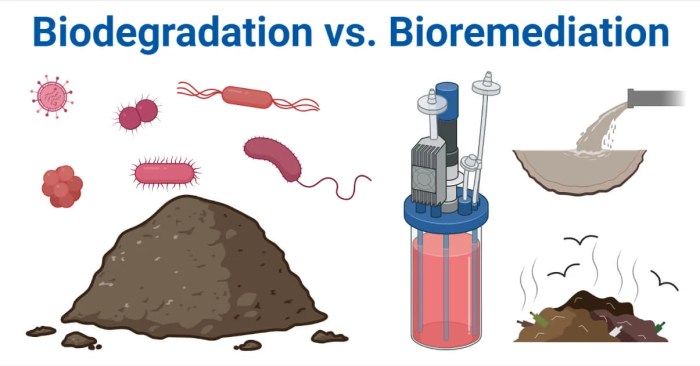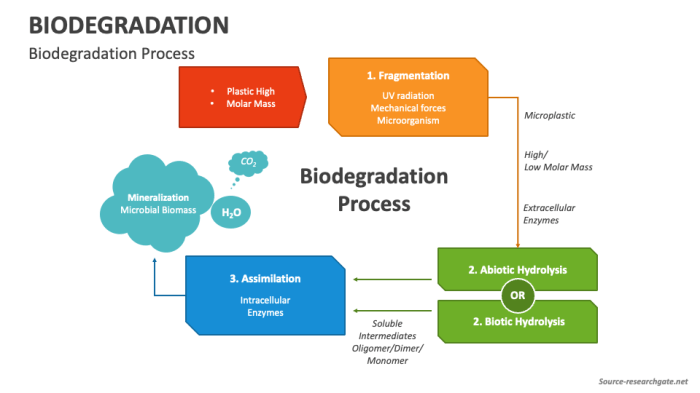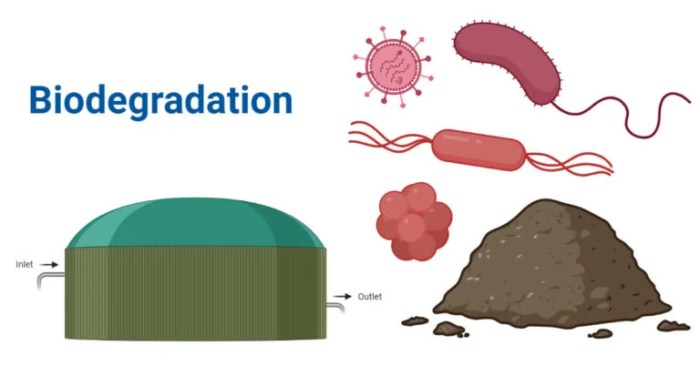Which of the following topics is related to bioremediation – Bioremediation, a captivating subject matter, takes center stage in this discourse, inviting readers into a realm of scientific exploration. As we delve into the intricate relationship between bioremediation and various disciplines, this comprehensive overview promises to illuminate the depths of this groundbreaking environmental remediation technique.
Bioremediation encompasses a diverse range of applications, from purifying contaminated soil and water to restoring ecosystems ravaged by pollution. Its potential for sustainable environmental cleanup projects has garnered significant attention, making it an increasingly crucial topic in environmental science.
1. Bioremediation Techniques

Bioremediation involves utilizing biological processes to remove or transform contaminants from the environment. Several techniques are employed, each with its own advantages and disadvantages.
In Situ Bioremediation
- Bioventing:Injects air into the contaminated zone, stimulating aerobic microorganisms to break down contaminants.
- Biosparging:Injects air or oxygen directly into the groundwater to enhance aerobic biodegradation.
- Bioaugmentation:Introduces specific microorganisms or microbial consortia to the contaminated site to enhance biodegradation.
Ex Situ Bioremediation
- Landfarming:Contaminants are spread over a prepared soil bed, where microorganisms degrade them under controlled conditions.
- Composting:Organic contaminants are mixed with bulking agents and aerated to create a favorable environment for microbial degradation.
- Bioreactors:Contaminants are treated in engineered systems that provide optimal conditions for microbial growth and biodegradation.
2. Bioremediation Applications
Bioremediation has found wide applications in various industries and environmental cleanup projects.
Wastewater Treatment
- Activated sludge systems use microorganisms to break down organic pollutants in wastewater.
- Anaerobic digesters convert organic matter into biogas, reducing waste volume and generating energy.
Soil Remediation
- Biopiles and landfarming are used to treat contaminated soils, removing hydrocarbons, pesticides, and other pollutants.
- Bioventing and biosparging are effective for remediating volatile organic compounds (VOCs) in soil.
Groundwater Remediation
- Bioaugmentation and biostimulation enhance the natural biodegradation of contaminants in groundwater.
- Permeable reactive barriers (PRBs) use microorganisms immobilized on a solid matrix to degrade contaminants.
3. Bioremediation Mechanisms
Bioremediation relies on the metabolic activities of microorganisms to break down contaminants.
Aerobic Biodegradation
Microorganisms use oxygen to break down organic contaminants into carbon dioxide, water, and other byproducts.
Anaerobic Biodegradation
Microorganisms break down organic contaminants in the absence of oxygen, producing methane, carbon dioxide, and other byproducts.
Cometabolism
Microorganisms degrade contaminants as a secondary process while metabolizing a primary substrate.
4. Factors Affecting Bioremediation: Which Of The Following Topics Is Related To Bioremediation
Several environmental factors influence the effectiveness of bioremediation.
Temperature, Which of the following topics is related to bioremediation
Optimal temperature ranges vary for different microorganisms, affecting their growth and metabolic activity.
pH
Extreme pH levels can inhibit microbial growth and biodegradation.
Nutrient Availability
Microorganisms require nutrients such as nitrogen and phosphorus for growth and biodegradation.
Site Characteristics
Soil type, groundwater flow, and presence of co-contaminants can impact biodegradation rates.
5. Bioremediation Monitoring and Evaluation

Monitoring is crucial to track the progress of bioremediation projects and evaluate their effectiveness.
Monitoring Plan
| Parameter | Frequency |
|---|---|
| Microbial population | Monthly |
| Contaminant concentrations | Quarterly |
| Groundwater quality | Semi-annually |
Performance Indicators
- Reduction in contaminant concentrations
- Increase in microbial population
- Improvement in groundwater quality
6. Case Studies of Bioremediation

Numerous successful bioremediation projects have demonstrated the effectiveness of this approach.
Case Study: Exxon Valdez Oil Spill
Bioremediation was used to treat the oil spill from the Exxon Valdez tanker, resulting in significant degradation of hydrocarbons.
Case Study: Love Canal Superfund Site
Bioremediation techniques were employed to clean up the Love Canal site contaminated with dioxins and other hazardous chemicals.
Case Study: Hanford Nuclear Site
Bioremediation is being used to address groundwater contamination at the Hanford Nuclear Site, removing uranium and other radioactive contaminants.
FAQ
What is the primary mechanism behind bioremediation?
Bioremediation relies on the metabolic capabilities of microorganisms, which break down and transform contaminants into less harmful substances.
What are the key factors that influence the effectiveness of bioremediation?
Environmental factors such as temperature, pH, nutrient availability, soil type, and groundwater flow can significantly impact the rate and efficiency of bioremediation processes.
What are the potential benefits of using bioremediation for environmental cleanup?
Bioremediation offers several advantages, including cost-effectiveness, reduced environmental impact, and the ability to address a wide range of contaminants.